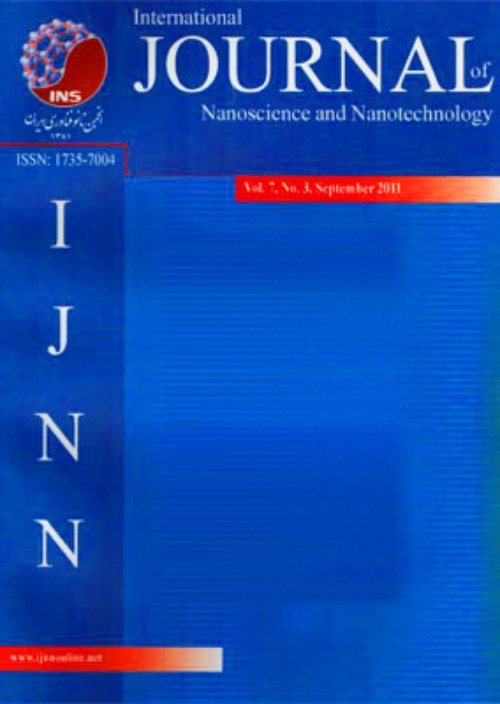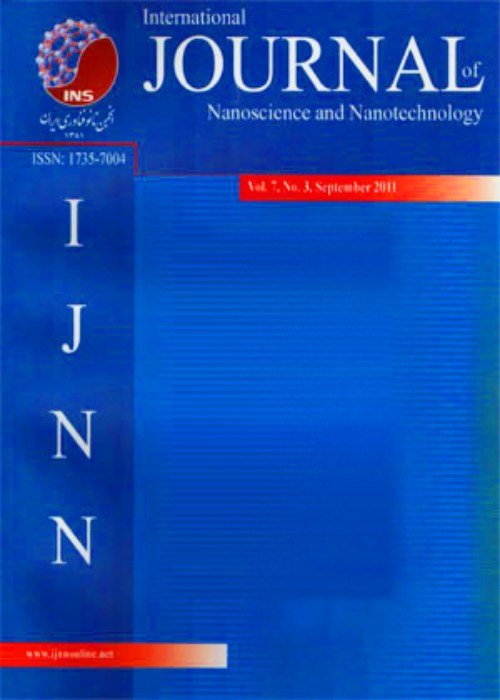فهرست مطالب

International Journal Of Nanoscience and Nanotechnology
Volume:18 Issue: 4, Autumn 2022
- تاریخ انتشار: 1401/09/10
- تعداد عناوین: 6
-
-
Pages 219-232In recent decades, nanotechnology-based treatments have made significant strides. Compared to monometallic nanoparticles, bimetallic nanoparticles have gained a great deal of technological and scientific interest due to their superior properties in various applications, which include the treatment of infectious disorders. Bimetallic nanoparticles are created by combining two distinct metals. Among the several bimetallic nanoparticles, silver-silica (Ag/Si) composites hold the most promise for fixing this problem. Ag/Si composites can be manufactured in many shapes, sizes, and structures by supporting them on their organic or inorganic counterparts. The characteristics of Ag/Si composites are superior to those of bimetallic nanoparticles. There are numerous obstacles involved with the characterization of composite materials. Due to the nanomaterials' strong reactivity and high accessible surface area, they are typically unstable and susceptible to coarse agglomeration. It is advised that the surface of nanoparticles be modified to prevent aggregation and agglomeration. Nanomaterials' behavior may impact the physicochemical properties of aggregates. This study examines the parameters that influence the synthesis of Ag/Si under varying conditions, including the effect of initial concentration of metal precursor, reaction time, reaction temperature, and calcination temperature. Based on several prior studies, the properties of the produced Ag/Si composites were subsequently reviewed via transmission electron microscopy (TEM), X-ray diffraction (XRD), X-ray photoelectron microscopy (XPS), energy dispersive X-ray (EDX), and Fourier transform infra-red (FTIR). The highlighted physicochemical properties are shape, crystallinity, and compositions. As a result of their decreased size and increased surface area, Ag/Si composites are widely utilized as catalysts. Drug delivery, water filtration, and catalysis are some of the applications of silver-silica nanocomposites.Keywords: Silver-silica composite, Synthesis Condition, Physicochemical, Bimetallic, Characterization.
-
Pages 233-240Vegetable oils have been widely used as a basic component or active ingredient in cosmetic formulations, based on the concept that they are safe and biocompatible with the skin. Oil in water (O/W) Nanoemulsions were produced using Rice bran and Babassu oils and low energy emulsification methods, to evaluate their physical stability. The addition of lavender (Lavandula officinalis) (LEO) essential oil in those NANOEMULSIONS promoted a reduction in droplet size, which can be explained by the possibility of the essential oil molecules to penetrate the interface of the droplet and change its properties, promoting stability to the nanoemulsion. This effect is more pronounced when the essential oil is used in association with other vegetable oils, indicating a synergy action on the stability mechanism. The nanoemulsion was stable over the course of this study. In vitro assays showed that this formulation has a low irritation potential, and when applied to human skin during in vivo studies, improved the skin's moisture content and maintained normal pH value. In this research stable nanoemulsions obtained using essential oil and vegetable oils were evaluated after a period of 60 days. All nanoemulsions physicochemical properties were maintained and particle size were around 77nm.Keywords: Nanoemulsion, Essential oils, Babassu, Rice, lavender, Melaleuca, stability, Droplet size.
-
Pages 241-250This paper proposes an enhanced anti-reflective surface by applying pyramid/nanowire textures to the silicon wafer. Before texturization, for the first time, we applied a pre-treatment process to the Si wafers using silver assisted chemical etching (MACE) process, which makes the silicon wafer porous. This porosity affects formation of the later synthesized micro pyramids with more uniformity in shape and distribution. For pyramid formation, the etching process of the p-type (100) silicon wafers in the KOH solution with different concentrations of 3, 5, and 7 wt.% along with the isopropyl alcohol is accomplished and surveyed. Micro pyramids are realized with different sizes based on the KOH concentration. In continue, the MACE process with Ag is applied to the pre-formed pyramids to realize the Si nanowires. Therefore, composite texturization of the silicon substrate is achieved. These combined nanowire/pyramid structures significantly reduce the light reflection of the silicon substrate. The acquired reflection factors are less than 3% (<3%). X-ray diffraction (XRD) is utilized to study the synthesized structures' crystalline characteristics which reveals the Si-cubic structure. Moreover, Raman spectroscopy results of the samples are also proposed.Keywords: Anti-reflective surface, Pyramid, nanowire structures, Silicon solar cells, Surface texturization, MACE.
-
Pages 251-264
Polyvinyl alcohol (PVA)-ZnO hybrid nanofluid (HNF) was prepared by a one-step chemical method. The structure of PVA-ZnO nanocomposite was concluded by XRD analysis. The stability of HNF was investigated by spectral absorbency analysis and photographic capture methods. 1 wt% PVA capped ZnO nanofluid was stable for 45 days. Zeta potential measurements confirmed that the enhanced stability of PVA-ZnO HNF is due to steric stabilization offered by the polymer. The thermal conductivity of HNFs was predicted by applying the Mixture rule to the conventional Maxwell and Xue models. The theoretical values predicted by the above models were in good agreement with the experimental values. However, it increased steeply with the onset of percolation and it exhibited an additive behaviour under percolation. Thermal conductivity of the prepared hybrid nanofluids increased with temperature and maximum thermal conductivity of the hybrid nanofluids was observed at 60oC with 0.009 weight% of solid dispersant. Theoretical models were used to explain the thermal conductivity of hybrid nanofluids in contrast to most of the reported work which has used empirical correlations. The additive model satisfactorily explained the thermal conductivity of hybrid nanofluids under percolation. TEM micrograph showed the formation of heat conducting path due to onset of percolation in PVA-ZnO HNF resulting 22.5% increase in thermal conductivity due to synergistic effect.
Keywords: PVA-ZnO nanocomposites, One-step synthesis, hybrid nanofluids, Thermal conductivity models. -
Pages 265-274
For the past couple of years, the synthesis of silver nanoparticles via the green route had gained much attention due to its cost-effectiveness and eco-friendly technology. Here we report for the first time, to the best of our knowledge the synthesis of silver nanoparticles from aqueous leaf extract of Curcuma Caesia plant and investigated its antimicrobial activity. The bio-reduced silver nanoparticles were characterized using UV-Visible spectroscopy, FTIR, XRD, TEM, and SEM. XRD showed the crystalline nature of nanoparticles, observed peaks (111), (220), (200), and (311). The formation of AgNPs is confirmed by recording the UV–vis absorption spectra for surface plasmon resonance (SPR) peak (∼446 nm). The antimicrobial examination of the silver nanoparticles shows great antibacterial action because of high zones of hindrance against test microscopic organisms.
Keywords: Green synthesis, Silver nanoparticles, XRD, TEM, Antimicrobial activity. -
Pages 275-284
This study endeavors to investigate the influence of calcination temperatures (650, 750 & 850°C) on the strontium ferrite (SrFe2O4) nanoparticles synthesized by the co-precipitation method. The prepared powder samples were characterized by various measurement techniques such as X-ray diffractometer (XRD), scanning electron microscopy (SEM), thermo gravimetric analysis (TGA), and vibrating sample magnetometer (VSM). Initially, the XRD patterns were confirmed the presence of spinel SrFe2O4 phases. Overall, the number of diffraction peaks increased due to the enhancement of calcination temperature. The SEM morphological features are shown the spherical-shaped nanoparticles with less agglomeration. Considerably, the agglomeration between the nanoparticles increased due to the higher calcination temperatures. However, the structural and morphological investigation was helpful and carried out for the TGA and VSM investigation. At 850°C calcination temperature, TGA revealed 5.8% of weight loss and VSM endorsed the magnetic properties such as high saturation magnetization (Ms), remanent magnetization (Mr) and coercivity (Hc) come out to be 37.26 emu/g, 19.788 emu/g and 6188.4 Oe, respectively.
Keywords: SrFe2O4, nanoparticles, Calcination, Thermal, Coercivity.


